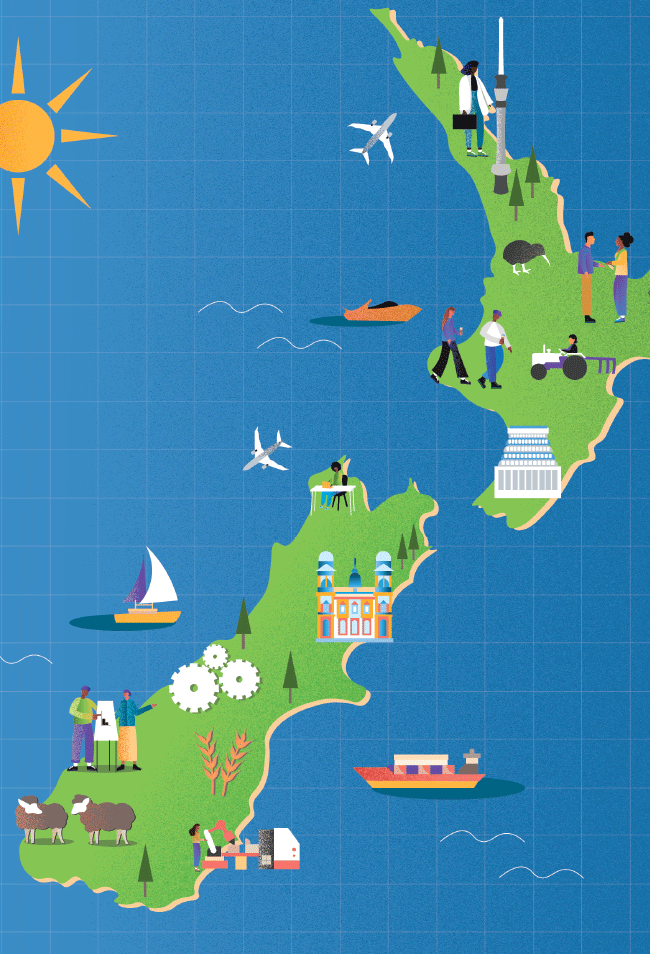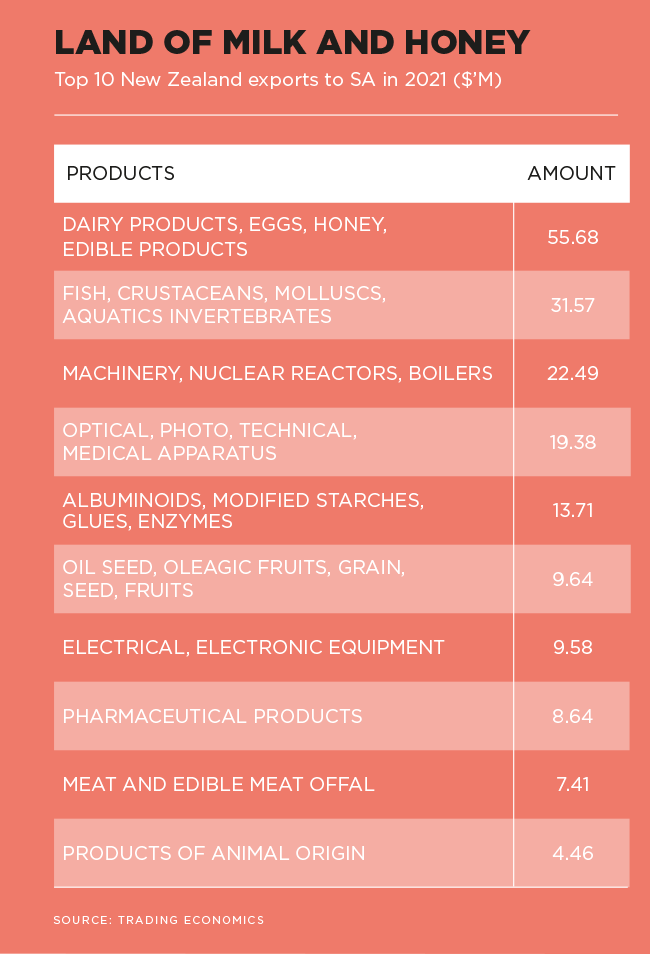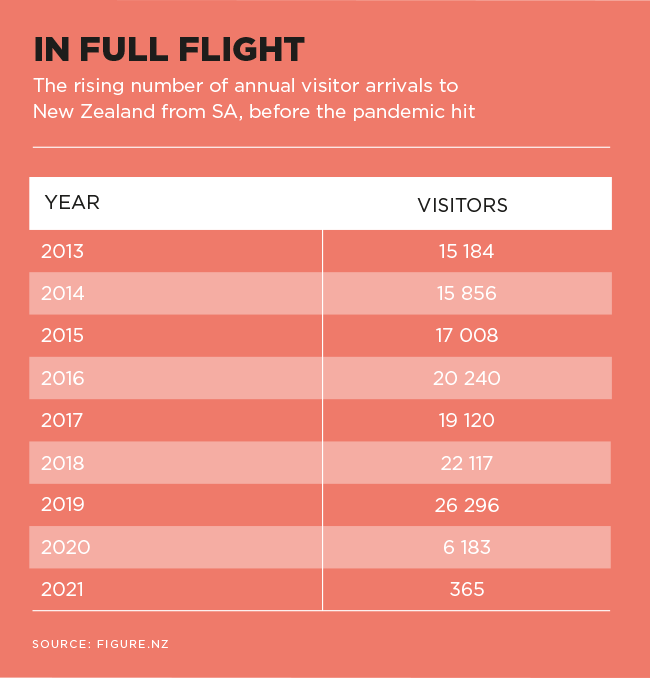Despite the distance and obvious differences (New Zealand’s population is about 5 million, one-twelfth of SA’s), the two countries loom large in one another’s views of the world.
This is testimony to the importance of cultural, personal and sporting links that massively outweigh economic ties. The friendly rivalry between the two countries is epitomised by their competitiveness on the rugby field. They are the world’s premier competitors in the sport, having shared six of the nine Rugby World Cups (three each) played since the competition was introduced in 1987. The New Zealand trade mission’s annual networking events for New Zealand business people in SA ‘usually centre on All Blacks rugby games’. The All Blacks (New Zealand) and Springboks (SA) are two of the most valuable brands in the sport. Since the game of rugby turned professional in 1995, it has been difficult to get a handle on the sport’s finances. However, in 2004, a consortium of SA, New Zealand and Australian rugby sold five years’ worth of broadcasting rights for $323 million to News Corp. A private-equity investment into New Zealand rugby in 2022 valued the industry in that country at NZ$3.5 billion. These sorts of numbers vastly exceed the trade figures between New Zealand and SA but speak to the cultural alignment between the two countries. New Zealand is, according to IMF’s 2021 projections, the world’s 21st-wealthiest economy, measured in (nominal) GDP per capita terms ($48 300). SA is ranked at 91 ($6 800). New Zealand’s wealth is based on agriculture and agro-processing, with the country having exported dairy and other animal products to the rest of the world for more than a century.
New Zealand, like many other countries, remains interested in the potential of an integrated African market, through the implementation of the African Continental Free Trade Area Agreement. It is a strong advocate of free trade, having been the first country to sign a free-trade agreement with China (in 2008). The High Commission in Pretoria considers the sub-Saharan Africa region to have ‘large potential’ and regards ‘South Africa’s role as a hub (for the operations of New Zealand businesses)’.
This interest in a consolidated African market is illustrated by New Zealand’s dairy industry. The sector is home to the biggest company in New Zealand, Fonterra, which is also one of the largest dairy companies in the world. Fonterra is the largest exporter of dry-milk powder and is second only to the EU when it comes to cheese exports.
‘Africa is one of the fastest-growing markets for dairy imports and a significant opportunity, not just for Fonterra, but the New Zealand dairy industry,’ according to Josh Hosking, then sales manager at Africa NZMP, Fonterra’s marketing arm. ‘The increasing incomes and population growth of Africa are really driving the middle class of African consumers, who are demanding higher-quality foods. Dairy nutrition is a key cornerstone to that.’
New Zealand faced and dealt with an economic crisis in the 1980s. The country had been able to rely on the UK market for sales of its agricultural exports – dairy products, mutton and wool – for many years. But that market was effectively closed when the UK joined the EU with its protectionist Common Agricultural Policy in 1973. This coincided with an international slump in the prices of primary agricultural commodities. By the early 1980s, New Zealand was suffering from debt, inflation and unemployment.
New Zealand’s way out of the economic quagmire was to intensify its commitment to market economics and the role of its private sector as a driver of growth. Starting with the election of a nominally left-wing Labour Party government, under the premiership of David Lange, in 1984, the government introduced a policy called Rogernomics, named after Finance Minister Roger Douglas.
New Zealand remains a market-friendly economy. Its Ministry of Foreign Affairs and Trade (MFAT) has even branded it the ‘New Zealand way of doing business’. This involves ‘keeping things simple and removing red tape’, an approach that, MFAT believes, ‘gives New Zealand companies a big advantage over their competitors’.
Ever since 2004 when the World Bank introduced the Doing Business indicators, which assess how friendly regulations are to the private sector, New Zealand has ranked at or very near the top every year. The country is also a consistent top performer in Transparency International’s annual index where a higher ranking indicates less corruption. With its top ranking in 2021, it may well be that New Zealand is the least corrupt society on Earth.
New Zealand’s total exports to SA in 2021 (dominated by animal products, especially dairy) were worth $208.32 million, a fraction of its total exports. SA is, in fact, New Zealand’s fourth-biggest market in Africa, behind Egypt, Algeria (one of the world’s largest powdered-milk importers) and Nigeria. SA’s exports to New Zealand account for an even smaller proportion of the total, being valued at about $97 million in 2021.
The cultural linkages are, however, much stronger. SA emigrants have found New Zealand a welcoming and accessible destination. In 2022, New Zealand is reported to host 60 000 SA immigrants which means that more than one in 100 New Zealand residents were born in SA. South Africans visit New Zealand in numbers out of all proportion to the scale of economic relations between the two nations. Although SA is only New Zealand’s 32nd-most important trading partner, it is that country’s 18th-largest source of foreign visitors.
Rugby rivalry is about much more than competition on the sports field. As former New Zealand Prime Minister Helen Clark once remarked, ‘New Zealand’s engagement on issues affecting South Africa in the past was often so intense that it shaped political debate in the country and even affected the outcome of at least one general election’. That is a reference to the 1984 election, which saw a Labour government displace New Zealand’s National Party in government.
New Zealand was deeply divided by the issue of whether to play sport with apartheid SA. Matters came to a head when the Springbok rugby team toured New Zealand in 1981 to be greeted by vociferous protests and the disruption of Test matches. The current Prime Minister, Jacinda Ardern, has noted that ‘the struggle against apartheid was supported in New Zealand through a mass-protest movement that opposed sporting contacts between out two countries’. She added that her own father, a policeman, missed her first birthday, ‘because he was called upon to work during the protests’.
New Zealand cut diplomatic relations with apartheid SA in 1984. The relationship was only resumed after SA’s democratisation in 1994. Since then, the New Zealand High Commission in Pretoria has become the focal point for the Pacific Island nation’s interest in sub-Saharan Africa. It is its only full embassy in Africa, south of Cairo, with other sub-Saharan countries being serviced by consulates.
Future ties appear to hinge on how quickly and effectively the African single-market mechanism can be implemented. That would be a win for both countries.










